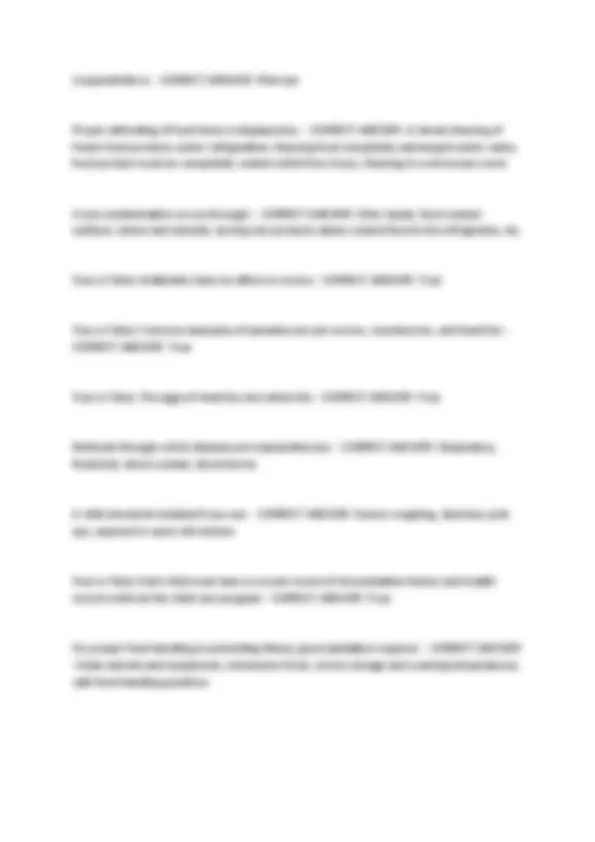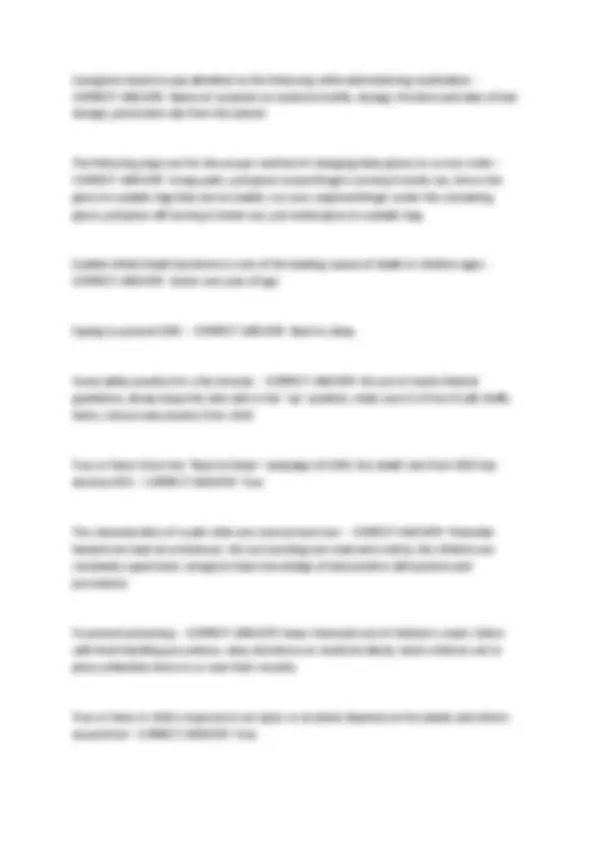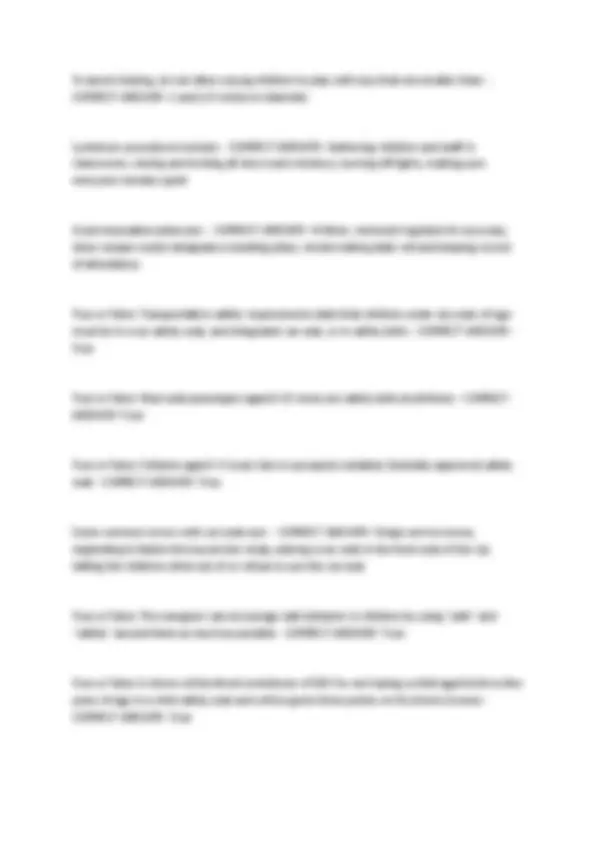






Study with the several resources on Docsity

Earn points by helping other students or get them with a premium plan


Prepare for your exams
Study with the several resources on Docsity

Earn points to download
Earn points by helping other students or get them with a premium plan
Community
Ask the community for help and clear up your study doubts
Discover the best universities in your country according to Docsity users
Free resources
Download our free guides on studying techniques, anxiety management strategies, and thesis advice from Docsity tutors
HEALTH, SAFETY, AND NUTRITION FOR DCF EXAM Children who have physical, emotional, or behavioral conditions that affect or delay development are referred to as having: - CORRECT ANSWER -Special needs True or False: Short term illnesses such as ear infections, colds, broken legs may only last a few days, weeks, or months - CORRECT ANSWER -True To prevent, identify, and control illness in a child care environment, a caregiver should perform a what with each child upon entering and leaving the program? - CORRECT ANSWER -Daily health check When you take an infants temperature by the auxiliary method, you are taking the temperature: - CORRECT ANSWER -Under the arm or armpit You can take the temperature of a child over three years of age by the following method: - CORRECT ANSWER -Orally and auxiliary In the case of diarrhea or vomiting, the caregiver should NOT what? - CORRECT ANSWER Give the child an adult sports drink
Typology: Exams
1 / 8

This page cannot be seen from the preview
Don't miss anything!





Children who have physical, emotional, or behavioral conditions that affect or delay development are referred to as having: - CORRECT ANSWER - Special needs True or False: Short term illnesses such as ear infections, colds, broken legs may only last a few days, weeks, or months - CORRECT ANSWER - True To prevent, identify, and control illness in a child care environment, a caregiver should perform a what with each child upon entering and leaving the program? - CORRECT ANSWER
What are the three As of a healthy child? - CORRECT ANSWER - Appetite, appearance, activity A physically healthy child has a good appetite. They can: - CORRECT ANSWER - Eat an appropriate amount of food at times, consume a vareity of foods, be interested in eating, and appear to be content after meals and snacks A physically healthy child has good appearance. They display: - CORRECT ANSWER - Clear and bright eyes, clear skin, age-appropriate muscles, steady gain in height and weight A healthy child, reflecting happy, cheerful feelings is displaying: - CORRECT ANSWER - Emotional health A child who is friendly most of the time, interacts with other children, enjoys quiet activities that require concentration is displaying: - CORRECT ANSWER - Social health True or False: The best way to take temperature is to use a digital thermometer with a disposable sheath - CORRECT ANSWER - True True or False: For mild diarrhea, give the child milk to drink - CORRECT ANSWER - False True or False: For both diarrhea and vomiting, stop the child's normal diet and give electrolytes - CORRECT ANSWER - True Hib is an infection that can lead to other conditions which can cause secondary infections in many area of the body including: - CORRECT ANSWER - Meningitis, pneumonia, epiglottis infection True or False: Hepatitis B and C are diseases of the liver - CORRECT ANSWER - True
Caregivers needs to pay attention to the following while administering medication: - CORRECT ANSWER - Name of recipient on medicine bottle, dosage, the time and date of last dosage, permission slip from the parent The following steps are for the proper method of changing latex gloves in correct order: - CORRECT ANSWER - Grasp palm, pull glove toward fingers turning it inside out, throw the glove in a plastic bag that can be sealed, run your ungloved finger under the remaining glove, pull glove off turning it inside out, put soiled glove in a plastic bag Sudden Infant Death Syndrome is one of the leading causes of death in children ages: - CORRECT ANSWER - Under one year of age Saying to prevent SIDS: - CORRECT ANSWER - Back to sleep Good safety practice for cribs include: - CORRECT ANSWER - Be sure it meets federal guidelines, always keep the side rails in the "up" position, make sure it is free of soft, fluffy items, remove any jewelry from child True or False: Since the "Back to Sleep" campaign of 1994, the death rate from SIDS has declines 40% - CORRECT ANSWER - True The characteristics of a safe child care environment are: - CORRECT ANSWER - Potential hazards are kept at a minimum, the surroundings are neat and orderly, the children are constantly supervised, caregivers have knowledge of and practice safe policies and procedures To prevent poisoning: - CORRECT ANSWER - keep chemicals out of children's reach, follow safe food-handling procedures, obey directions on medicine labels, teach children not to place unfamiliar items in or near their mouths. True or False: A child's response to an injury or accident depends on the adults and others around him - CORRECT ANSWER - True
To avoid choking, do not allow young children to play with toys that are smaller than: - CORRECT ANSWER - 1 and 1/4 inches in diameter Lockdown procedures include: - CORRECT ANSWER - Gathering children and staff in classrooms, closing and locking all doors and windows, turning off lights, making sure everyone remains quiet Good evacuation plans are: - CORRECT ANSWER - Written, reviewed regularly for accuracy, show escape routes designate a meeting place, involve taking daily roll and keeping record of attendance True or False: Transportation safety requirements state that children under six years of age must be in a car safety seat, and integrated car seat, or in safety belts - CORRECT ANSWER - True True or False: Rear-seat passengers aged 6-15 must use safety belts at all times - CORRECT ANSWER - True True or False: Children aged 0-3 must ride in a properly installed, federally-approved safety seat - CORRECT ANSWER - True Some common errors with car seats are: - CORRECT ANSWER - Straps are too loose, neglecting to fasten the top anchor strap, placing a car seat in the front seat of the car, letting the children climb out of or refuse to use the car seat True or False: The caregiver can encourage safe behavior in children by using "safe" and "safety" around them as much as possible - CORRECT ANSWER - True True or False: A driver will be fined a minimum of $60 for not having a child aged birth to five years of age in a child safety seat and will be given three points on his drivers license - CORRECT ANSWER - True
The following foods present choking concerns for small children: - CORRECT ANSWER - Hot dogs, grapes, peanut butter, carrots What should be considered when determining if a food is a choking hazard for young children? - CORRECT ANSWER - The size, texture, and shape of the food When should you burp a baby? - CORRECT ANSWER - At the beginning and end of a feeding Leftover breast milk should be: - CORRECT ANSWER - Discarded HIV is a: - CORRECT ANSWER - virus Establishing and following what is an effective way of maintaining a safe and healthy child care program - CORRECT ANSWER - Written policy Daily health checks: - CORRECT ANSWER - Good way of preventing, identifying, controlling illness in a child care environment Daily health checks: - CORRECT ANSWER - Behavior: General mood (unusually quiet, irritable, drowsy, or restless), unusual behavior, activity level, breathing difficulties, severe coughing or sneezing, hoarseness Physical: skin color, unusual spots or rashes, swelling or bruises, sores, discharge from nose,ears,eyes, eyes red,irritated,sensitive to light Determining if a child has a fever: - CORRECT ANSWER - Temperature- orally: 101 under arm: 100 If dehydration is severe, the following will occur: - CORRECT ANSWER - Eyes are sunken, hands and feet are cold and blotchy, pulse may seem weak and fast, child will not urinate for hours
The steps to prevent dehydration are dependent on the child's symptoms and can include: - CORRECT ANSWER - Do not give milk, for vomiting stop giving solid food and give water at 30 or 60 minute intervals, for both diarrhea and vomiting stop the child's normal diet and give electrolytes, do not give a child sports drinks Heat Exhaustion steps: - CORRECT ANSWER - Child's emergency contact should be notified, lay the person down in a cool and quiet place with their feet raised a little bit, loosen any tight clothing, supply water or sports drink to drink, use other cooling measures, If signs or symptoms worsen or do not improve within an hour or temperature reaches 104, seek medical attention